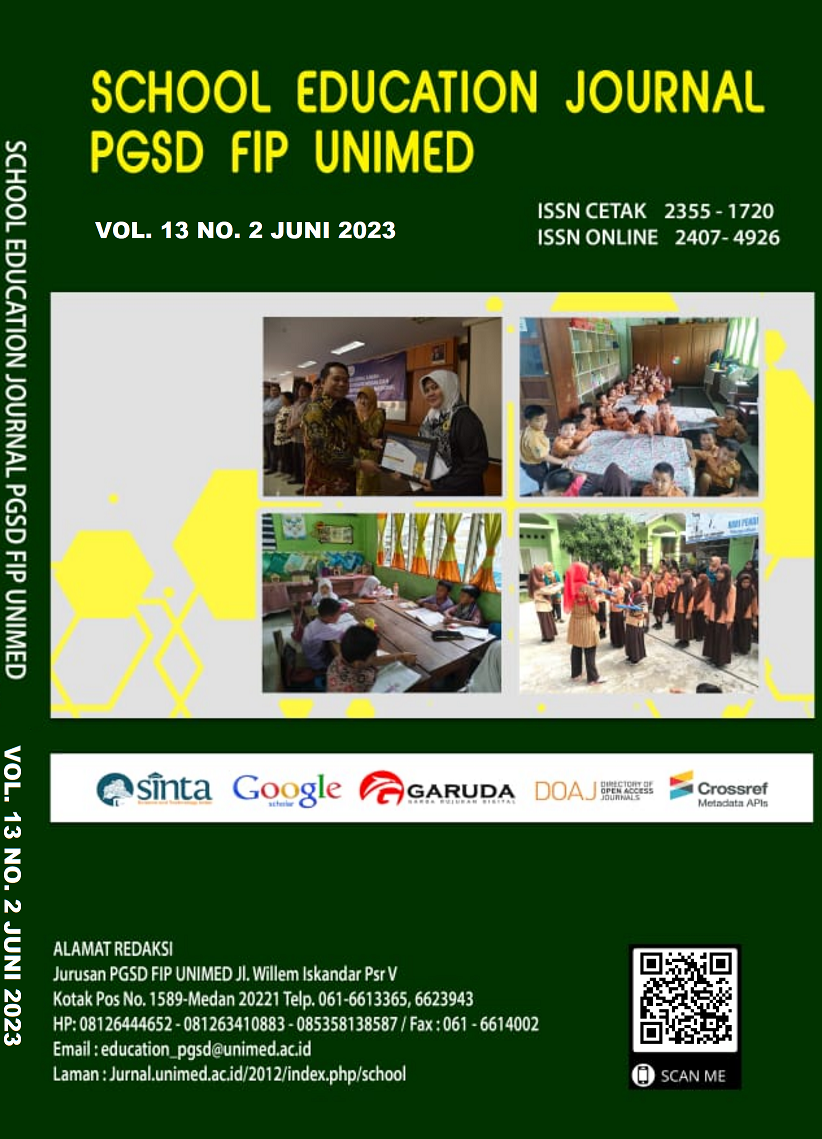ANALISIS KOMUNIKASI PEMBELAJARAN GURU KELAS DENGAN SISWA KELAS VI DI SEKOLAH DASAR
DOI:
https://doi.org/10.24114/sejpgsd.v13i2.46120Keywords:
Classroom teacher Learning Communication, Students.Abstract
The study was entitled œ Analysis of Class Teacher Learning Communication with Class VI Students SD N 6 Onanrunggu Learning Year 2022/2023. This research was carried out to discover how Class Teacher Learning Communication With Class VI Students. The research method used is a qualitative method with the approach in this study is a case study approach to produce descriptive data in the form of written or oral words from the subject/actors and behaviors that can be observed with the aim of knowing deeply and trying to find the underlying meaning regarding Class Teacher Learning Communication with Students. Learning communication is a reciprocal relationship between teachers (communicator) who deliver messages to students ( comunicant) as recipients of messages through media that accumulate certain effects. The data analysis techniques used in this study are data collection, data reduction, data display and verifiying. Based on the results of the study it can be concluded that in general Class Teacher Learning Communication With Class VI Students SD N 6 Onanrunggu is not yet maximum.References
Dakhi, A. S. 2021. Peningkatan Disiplin Siswa Dengan Kompetensi Guru Dan Kepemimpinan Kepala Sekolah. Jurnal Dinamika Pendidikan, 14(3), 131“143.
Illahi, N. 2020. Peranan Guru Profesional Dalam Peningkatan Prestasi Siswa Dan Mutu Pendidikan Di Era Milenial. Jurnal Asy-Syukriyyah, 21(1), 1“20. https://doi.org/10.36769/asy.v21i1.94
Mailani, E. (2015). Penerapan Pembelajaran Yang Menyenangkan. Elementary School Journal PGSD FIP Unimed, 1(1), 8“11.
Purba, Y. E., Sinaga, R., Juliana, & Tanjung, D. S. (2022). Penerapan Model Pembelajaran Artikulasi dalam Meningkatkan Hasil Belajar di Kelas V SD Negeri 060935 Medan Johor. Primary : Jurnal Pendidikan Guru Sekolah Dasar, 11(5), 1420“1429.
R
itonga, C. C., Tanjung, D. S., & Sitepu, A. 2021. Pengaruh Model Pembelajaran Circuit Learning terhadap Hasil Belajar Siswa Tema Daerah Tempat Tinggalku Kelas IV SD Negeri 101735 Sei Semayang. Elementary School Journal PGSD FIP Unimed, 11(3), 246“255.
Rohmah, N. 2021. Upaya Guru dalam Mengatasi Kesulitan Peserta Didik Pada Pembelajaran Membaca, Menulis, dan Berhitung (Calistung) di MI Nahdlatul Ulama Gribig Kudus (Doctoral dissertation, IAIN KUDUS).
Sembiring, S. B., Tanjung, D. S., & Juliana. 2021. Pengaruh Model Pembelajaran Example Non Example terhadap Hasil Belajar Siswa pada Pembelajaran Tematik di Sekolah Dasar. EDUKATIF : JURNAL ILMU PENDIDIKAN, 3(6), 4075“4082.
Sinaga, R., & Tanjung, D. S. 2019. Efektifitas Penggunaan Interactive Educational Multimedia Learning Berbasis Teori Kognitif terhadap Dyslexic Student di Sekolah Dasar. Jurnal Guru Kita, 3(4), 338“341.
Sinurat, R., Tanjung, D. S., Anzelina, D., & Abi, A. R. 2021. Analisis Cara Belajar Siswa Berprestasi Kelas IV di SDN 097376 Sippan. Jurnal Ilmiah Pendidikan Sekolah Dasar, 14(1), 28“37.
Tanjung, D. S., Mahulae, S., & Tumanggor, A. F. M. (2022). Pengaruh Model Pembelajaran Picture and Picture Berbantuan Media Audio Visual Terhadap Hasil Belajar Siswa. Jurnal Mutiara Pendidikan Indonesia, 7(2), 145“154.
Tanjung, D. S., Sembiring, R. K., & Habeahan, D. F. 2022. Pengaruh Penggunaan Gadget terhadap Hasil Belajar Siswa Pada Mata Pelajaran Bahasa Indonesia Kelas III di Sekolah Dasar Medan. School Education Journal PGSD Fip Unimed, 12(2), 176“184.
Zulfiati, H. M. 2014. Peran Dan Fungsi Guru Sekolah Dasar Dalam Memajukan Dunia Pendidikan. Jurnal Pendidikan Ke-SD-An, 1(14), 1“4.
Downloads
Published
Issue
Section
License
Authors whose manuscripts are approved are approved as follows:
The publication rights for all journal manuscript materials published/published on the SEJ (School Education Journal) E-Journal site are held by the editorial board with the author's knowledge (moral rights remain with the manuscript authors).
The formal legal requirements for accessing this electronic digital journal article are subject to the terms of the Creative Commons Attribution-ShareAlike (CC BY) license, which means that E-Journal SEJ (School Education Journal) has the right to store, transfer media/format, manage in the form of a database, maintain, and publish articles without asking permission from the author as long as the author's name remains as the copyright owner.
Manuscripts published/published electronically are open access for educational, research, and library purposes.

